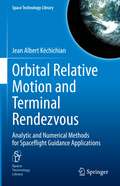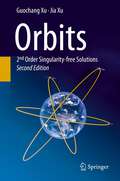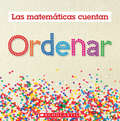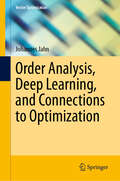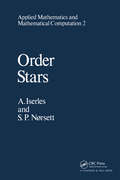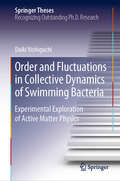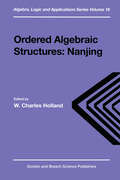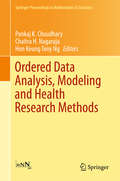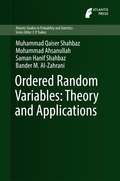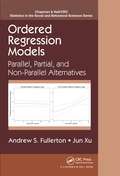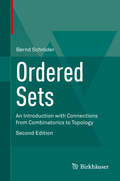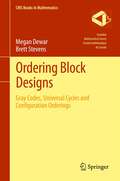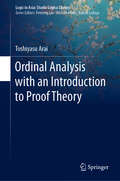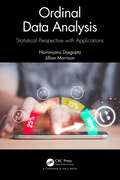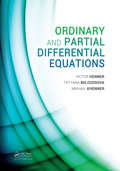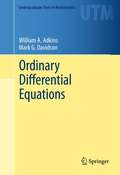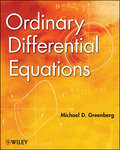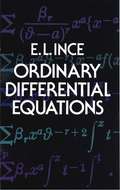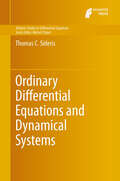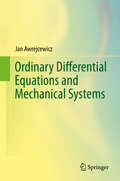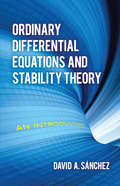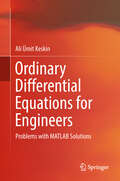- Table View
- List View
Orbital Relative Motion and Terminal Rendezvous: Analytic and Numerical Methods for Spaceflight Guidance Applications (Space Technology Library #39)
by Jean Albert KéchichianThis book provides a comprehensive analysis of time-fixed terminal rendezvous around the Earth using chemical propulsion.The book has two main objectives. The first is to derive the mathematics of relative motion in near-circular orbit when subjected to perturbations emanating from the oblateness of the Earth, third-body gravity, and atmospheric drag. The mathematics are suitable for quick trajectory prediction and the creation of computer codes and efficient software to solve impulsive maneuvers and fly rendezvous missions.The second objective of this book is to show how the relative motion theory is applied to the exact precision-integrated, long-duration, time-fixed terminal rendezvous problem around the oblate Earth for the general elliptic orbit case.The contents are both theoretical and applied, with long-lasting value for aerospace engineers, trajectory designers, professors of orbital mechanics, and students at the graduate level and above.
Orbits
by Guochang Xu Jia XuThe development of the orbits theory lags behind the development of satellite technology. This book provides, for the first time in the history of human satellite development, the complete third order solution of the orbits under all possible disturbances. It describes the theory of satellite orbits, derives the complete solutions of the orbital disturbances, describes the algorithms of orbits determination based on the theory, describes the applications of the theory to the phenomenon of the satellite formation physically. The subjects include: Orbits Motion Equations, Disturbance theory, Solutions of the differential Equations, Algorithms of Orbits determinations, Applications of the theory to the satellite formation.
Ordenar (Math Counts, New and Updated)
by Henry PluckroseAn introduction to sorting for the youngest readers!Una serie de libros para introducir a los lectores jóvenes a conceptos matemáticos fundamentales, ¡ahora en español!Math Counts series introduces young readers (grades K-3) to early math concepts. Real-world examples and corresponding photos make math concepts easy to grasp.When things are sorted together, they are called a set. Things that make up a set have something in common.Las verduras del supermercado están agrupadas. ¡Han sido ordenados en conjuntos! Todas las cosas que forman un conjunto tienen algo en común. Con ejemplos de la vida real, fotografías convincentes y textos inspiradores, ¡esta es la introducción perfecta al concepto matemático de "ordenar" para los lectores más jóvenes!Sobre la Serie:Publicada originalmente en los años 90 y actualizada recientemente, esta revolucionaria serie superventas inicia a los niños en el camino de aprender a comunicarse y razonar matemáticamente.La base de las matemáticas son las ideas, y estos libros se han desarrollado para que los niños vean, hablen, toquen y experimenten con estas ideas. Las fotografías atractivas y el texto sencillo y directo hacen de esta serie una herramienta perfecta para leer individualmente o en voz alta. Diez conceptos matemáticos fundamentales, uno para cada libro de la serie, están desarrollados de forma excelente, y ofrecen un apoyo curricular ideal. Esta serie es la mejor manera de iniciar el camino hacia el dominio de las matemáticas.
Order Analysis, Deep Learning, and Connections to Optimization (Vector Optimization)
by Johannes JahnThis book introduces readers to order analysis and various aspects of deep learning, and describes important connections to optimization, such as nonlinear optimization as well as vector and set optimization. Besides a review of the essentials, this book consists of two main parts. The first main part focuses on the introduction of order analysis as an application-driven theory, which allows to treat order structures with an analytical approach. Applications of order analysis to nonlinear optimization, as well as vector and set optimization with fixed and variable order structures, are discussed in detail. This means there are close ties to finance, operations research, and multicriteria decision making. Deep learning is the subject of the second main part of this book. In addition to the usual basics, the focus is on gradient methods, which are investigated in the context of complex models with a large number of parameters. And a new fast variant of a gradient method is presented in this part. Finally, the deep learning approach is extended to data sets given by set-valued data. Although this set-valued approach is more computationally intensive, it has the advantage of producing more robust predictions. This book is primarily intended for researchers in the fields of optimization, order theory, or artificial intelligence (AI), but it will also benefit graduate students with a general interest in these fields. The book assumes that readers have a basic understanding of functional analysis or at least basic analysis. By unifying and streamlining existing approaches, this work will also appeal to professionals seeking a comprehensive and straightforward perspective on AI or order theory approaches.
Order Stars: Theory and Applications
by A. Iserles S.P. NorsettThis book familiarizes the mathematical community with an analytic tool that is capable of so many applications and presents a list of open problems which might be amenable to analysis with order stars.
Order and Fluctuations in Collective Dynamics of Swimming Bacteria: Experimental Exploration of Active Matter Physics (Springer Theses)
by Daiki NishiguchiThis thesis focuses on experimental studies on collective motion using swimming bacteria as model active-matter systems. It offers comprehensive reviews of state-of-the-art theories and experiments on collective motion from the viewpoint of nonequilibrium statistical physics. The author presents his experimental studies on two major classes of collective motion that had been well studied theoretically. Firstly, swimming filamentous bacteria in a thin fluid layer are shown to exhibit true, long-range orientational order and anomalously strong giant density fluctuations, which are considered universal and landmark signatures of collective motion by many numerical and theoretical works but have never been observed in real systems. Secondly, chaotic bacterial turbulence in a three-dimensional dense suspension without any long-range order as described in the first half is demonstrated to be capable of achieving antiferromagnetic vortex order by imposing a small number of constraints with appropriate periodicity. The experimental results presented significantly advance our fundamental understanding of order and fluctuations in collective motion of motile elements and their future applications.
Ordered Algebraic Structures (Algebra, Logic and Applications)
by W. Charles HollandThis book is an outcome of the conference on ordered algebraic structures held at Nanjing. It covers a range of topics: lattice theory, ordered semi groups, partially ordered groups, totally ordered groups, lattice-ordered groups, and ordered fields.
Ordered Data Analysis, Modeling and Health Research Methods
by Pankaj K. Choudhary Chaitra H. Nagaraja Hon Keung Tony NgThis volume presents an eclectic mix of original research articles in areas covering the analysis of ordered data, stochastic modeling and biostatistics. These areas were featured in a conference held at the University of Texas at Dallas from March 7 to 9, 2014 in honor of Professor H. N. Nagaraja's 60th birthday and his distinguished contributions to statistics. The articles were written by leading experts who were invited to contribute to the volume from among the conference participants. The volume is intended for all researchers with an interest in order statistics, distribution theory, analysis of censored data, stochastic modeling, time series analysis, and statistical methods for the health sciences, including statistical genetics.
Ordered Random Variables: Theory and Applications
by Mohammad Ahsanullah Muhammad Qaiser Shahbaz Saman Hanif Shahbaz Bander M. Al-ZahraniOrdered Random Variables have attracted several authors. The basic building block of Ordered Random Variables is Order Statistics which has several applications in extreme value theory and ordered estimation. The general model for ordered random variables, known as Generalized Order Statistics has been introduced relatively recently by Kamps (1995).
Ordered Regression Models: Parallel, Partial, and Non-Parallel Alternatives (Chapman & Hall/CRC Statistics in the Social and Behavioral Sciences)
by Jun Xu Andrew S. FullertonOrdered Regression Models: Parallel, Partial, and Non-Parallel Alternatives presents regression models for ordinal outcomes, which are variables that have ordered categories but unknown spacing between the categories. The book provides comprehensive coverage of the three major classes of ordered regression models (cumulative, stage, and adjacent) as well as variations based on the application of the parallel regression assumption.The authors first introduce the three "parallel" ordered regression models before covering unconstrained partial, constrained partial, and nonparallel models. They then review existing tests for the parallel regression assumption, propose new variations of several tests, and discuss important practical concerns related to tests of the parallel regression assumption. The book also describes extensions of ordered regression models, including heterogeneous choice models, multilevel ordered models, and the Bayesian approach to ordered regression models. Some chapters include brief examples using Stata and R.This book offers a conceptual framework for understanding ordered regression models based on the probability of interest and the application of the parallel regression assumption. It demonstrates the usefulness of numerous modeling alternatives, showing you how to select the most appropriate model given the type of ordinal outcome and restrictiveness of the parallel assumption for each variable.Web ResourceMore detailed examples are available on a supplementary website. The site also contains JAGS, R, and Stata codes to estimate the models along with syntax to reproduce the results.
Ordered Sets
by Bernd SchröderAn introduction to the basic tools of the theory of (partially) ordered sets such as visualization via diagrams, subsets, homomorphisms, important order-theoretical constructions and classes of ordered sets. Using a thematic approach, the author presents open or recently solved problems to motivate the development of constructions and investigations for new classes of ordered sets. The text can be used as a focused follow-up or companion to a first proof (set theory and relations) or graph theory course.
Ordering Block Designs
by Megan Dewar Brett StevensThe study of combinatorial block designs is a vibrant area of combinatorial mathematics with connections to finite geometries, graph theory, coding theory and statistics. The practice of ordering combinatorial objects can trace its roots to bell ringing which originated in 17th century England, but only emerged as a significant modern research area with the work of F. Gray and N. de Bruijn. These two fascinating areas of mathematics are brought together for the first time in this book. It presents new terminology and concepts which unify existing and recent results from a wide variety of sources. In order to provide a complete introduction and survey, the book begins with background material on combinatorial block designs and combinatorial orderings, including Gray codes -- the most common and well-studied combinatorial ordering concept -- and universal cycles. The central chapter discusses how ordering concepts can be applied to block designs, with definitions from existing (configuration orderings) and new (Gray codes and universal cycles for designs) research. Two chapters are devoted to a survey of results in the field, including illustrative proofs and examples. The book concludes with a discussion of connections to a broad range of applications in computer science, engineering and statistics. This book will appeal to both graduate students and researchers. Each chapter contains worked examples and proofs, complete reference lists, exercises and a list of conjectures and open problems. Practitioners will also find the book appealing for its accessible, self-contained introduction to the mathematics behind the applications.
Ordinal Analysis with an Introduction to Proof Theory (Logic in Asia: Studia Logica Library)
by Toshiyasu AraiThis book provides readers with a guide to both ordinal analysis, and to proof theory. It mainly focuses on ordinal analysis, a research topic in proof theory that is concerned with the ordinal theoretic content of formal theories. However, the book also addresses ordinal analysis and basic materials in proof theory of first-order or omega logic, presenting some new results and new proofs of known ones.Primarily intended for graduate students and researchers in mathematics, especially in mathematical logic, the book also includes numerous exercises and answers for selected exercises, designed to help readers grasp and apply the main results and techniques discussed.
Ordinal Data Analysis: Statistical Perspective with Applications
by Nairanjana Dasgupta Jillian MorrisonThis book is a step-by-step data story for analyzing ordinal data from start to finish. The book is for researchers, statisticians and scientists who are working with datasets where the response is ordinal. This type of data is common in many disciplines, not just in surveys (as is often thought). For example, in the biological sciences, there is an interest in understanding and predicting the (growth) stage (of a plant or animal) based on a multitude of factors. Likewise, ordinal data is common in environmental sciences (for example, stage of a storm), chemical sciences (for example, type of reaction), physical sciences (for example, stage of damage when force is applied), medical sciences (for example, degree of pain) and social sciences (for example, demographic factors like social status categorized in brackets). There has been no complete text about how to model an ordinal response as a function of multiple numerical and categorical predictors. There has always been a reluctance and reticence towards ordinal data as it lies in a no-man’s land between numerical and categorical data. Examples from health sciences are used to illustrate in detail the process of how to analyze ordinal data, from exploratory analysis to modeling, to inference and diagnostics. This book also shows how Likert-type analysis is often used incorrectly and discusses the reason behind it. Similarly, it discusses the methods related to Structural Equations and talks about appropriate uses of this class of methods.The text is meant to serve as a reference book and to be a “how-to” resource along with the “why” and “when” for modeling ordinal data.Key Features: Includes applications of the statistical theory Includes illustrated examples with the associated R and SAS code Discusses the key differences between the different methods that are used for ordinal data analysis Bridges the gap between methods for ordinal data analysis used in different disciplines
Ordinal Definability and Recursion Theory: The Cabal Seminar, Volume III
by Alexander S. Kechris Benedikt Löwe John R. SteelThe proceedings of the Los Angeles Caltech-UCLA 'Cabal Seminar' were originally published in the 1970s and 1980s. Ordinal Definability and Recursion Theory is the third in a series of four books collecting the seminal papers from the original volumes together with extensive unpublished material, new papers on related topics and discussion of research developments since the publication of the original volumes. Focusing on the subjects of 'HOD and its Local Versions' (Part V) and 'Recursion Theory' (Part VI), each of the two sections is preceded by an introductory survey putting the papers into present context. These four volumes will be a necessary part of the book collection of every set theorist.
Ordinary And Partial Differential Equations
by Victor Henner Tatyana Belozerova Mikhail KhennerCovers ODEs and PDEs—in One Textbook Until now, a comprehensive textbook covering both ordinary differential equations (ODEs) and partial differential equations (PDEs) didn’t exist. Fulfilling this need, Ordinary and Partial Differential Equations provides a complete and accessible course on ODEs and PDEs using many examples and exercises as well as intuitive, easy-to-use software. Teaches the Key Topics in Differential Equations The text includes all the topics that form the core of a modern undergraduate or beginning graduate course in differential equations. It also discusses other optional but important topics such as integral equations, Fourier series, and special functions. Numerous carefully chosen examples offer practical guidance on the concepts and techniques. Guides Students through the Problem-Solving Process Requiring no user programming, the accompanying computer software allows students to fully investigate problems, thus enabling a deeper study into the role of boundary and initial conditions, the dependence of the solution on the parameters, the accuracy of the solution, the speed of a series convergence, and related questions. The ODE module compares students’ analytical solutions to the results of computations while the PDE module demonstrates the sequence of all necessary analytical solution steps.
Ordinary Differential Equations
by Bernd J. SchroersOrdinary Differential Equations introduces key concepts and techniques in the field and shows how they are used in current mathematical research and modelling. It deals specifically with initial value problems, which play a fundamental role in a wide range of scientific disciplines, including mathematics, physics, computer science, statistics and biology. This practical book is ideal for students and beginning researchers working in any of these fields who need to understand the area of ordinary differential equations in a short time.<P> Advisory: Bookshare has learned that this book offers only partial accessibility. We have kept it in the collection because it is useful for some of our members. To explore further access options with us, please contact us through the Book Quality link on the right sidebar. Benetech is actively working on projects to improve accessibility issues such as these.
Ordinary Differential Equations
by Mark G. Davidson William A. AdkinsUnlike most texts in differential equations, this textbook gives an early presentation of the Laplace transform, which is then used to motivate and develop many of the remaining differential equation concepts for which it is particularly well suited. For example, the standard solution methods for constant coefficient linear differential equations are immediate and simplified, and solution methods for constant coefficient systems are streamlined. By introducing the Laplace transform early in the text, students become proficient in its use while at the same time learning the standard topics in differential equations. The text also includes proofs of several important theorems that are not usually given in introductory texts. These include a proof of the injectivity of the Laplace transform and a proof of the existence and uniqueness theorem for linear constant coefficient differential equations. Along with its unique traits, this text contains all the topics needed for a standard three- or four-hour, sophomore-level differential equations course for students majoring in science or engineering. These topics include: first order differential equations, general linear differential equations with constant coefficients, second order linear differential equations with variable coefficients, power series methods, and linear systems of differential equations. It is assumed that the reader has had the equivalent of a one-year course in college calculus.
Ordinary Differential Equations
by Michael D. GreenbergFeatures a balance between theory, proofs, and examples and provides applications across diverse fields of studyOrdinary Differential Equations presents a thorough discussion of first-order differential equations and progresses to equations of higher order. The book transitions smoothly from first-order to higher-order equations, allowing readers to develop a complete understanding of the related theory.Featuring diverse and interesting applications from engineering, bioengineering, ecology, and biology, the book anticipates potential difficulties in understanding the various solution steps and provides all the necessary details. Topical coverage includes:First-Order Differential EquationsHigher-Order Linear EquationsApplications of Higher-Order Linear EquationsSystems of Linear Differential EquationsLaplace TransformSeries SolutionsSystems of Nonlinear Differential EquationsIn addition to plentiful exercises and examples throughout, each chapter concludes with a summary that outlines key concepts and techniques. The book's design allows readers to interact with the content, while hints, cautions, and emphasis are uniquely featured in the margins to further help and engage readers.Written in an accessible style that includes all needed details and steps, Ordinary Differential Equations is an excellent book for courses on the topic at the upper-undergraduate level. The book also serves as a valuable resource for professionals in the fields of engineering, physics, and mathematics who utilize differential equations in their everyday work. An Instructors Manual is available upon request. Email sfriedman@wiley.com for information. There is also a Solutions Manual available. The ISBN is 9781118398999.
Ordinary Differential Equations (Dover Books on Mathematics)
by Edward L. InceThe theory of ordinary differential equations in real and complex domains is here clearly explained and analyzed. Not only classical theory, but also the main developments of modern times are covered. Exhaustive sections on the existence and nature of solutions, continuous transformation groups, the algebraic theory of linear differential systems, and the solution of differential equations by contour integration are as valuable to the pure mathematician as the fine treatment of the equations of Legendre, Bessel, and Mathieu, the conditions for the oscillatory character of solutions of a differential equation, and the relation between a linear differential system and an integral equation are to the engineer and the physicist.Partial contents: real domain (elementary methods of integration, the existence and nature of solutions, continuous transformation-groups, linear differential equations-the general theory, with constant coefficients, solutions, algebraic theory, Sturmian theory, and later developments); complex domain (existence theorems, equations of first order, non-linear equations of higher order, solutions, systems, classifications of linear equations, oscillation theorems).
Ordinary Differential Equations and Dynamical Systems
by Thomas C. SiderisThis book is a mathematically rigorous introduction to the beautiful subject of ordinary differential equations for beginning graduate or advanced undergraduate students. Students should have a solid background in analysis and linear algebra. The presentation emphasizes commonly used techniques without necessarily striving for completeness or for the treatment of a large number of topics. The first half of the book is devoted to the development of the basic theory: linear systems, existence and uniqueness of solutions to the initial value problem, flows, stability, and smooth dependence of solutions upon initial conditions and parameters. Much of this theory also serves as the paradigm for evolutionary partial differential equations. The second half of the book is devoted to geometric theory: topological conjugacy, invariant manifolds, existence and stability of periodic solutions, bifurcations, normal forms, and the existence of transverse homoclinic points and their link to chaotic dynamics. A common thread throughout the second part is the use of the implicit function theorem in Banach space. Chapter 5, devoted to this topic, the serves as the bridge between the two halves of the book.
Ordinary Differential Equations and Mechanical Systems
by Jan AwrejcewiczThis book applies a step-by-step treatment of the current state-of-the-art of ordinary differential equations used in modeling of engineering systems/processes and beyond. It covers systematically ordered problems, beginning with first and second order ODEs, linear and higher-order ODEs of polynomial form, theory and criteria of similarity, modeling approaches, phase plane and phase space concepts, stability optimization and ending on chaos and synchronization. Presenting both an overview of the theory of the introductory differential equations in the context of applicability and a systematic treatment of modeling of numerous engineering and physical problems through linear and non-linear ODEs, the volume is self-contained, yet serves both scientific and engineering interests. The presentation relies on a general treatment, analytical and numerical methods, concrete examples and engineering intuition. The scientific background used is well balanced between elementary and advanced level, making it as a unique self-contained source for both theoretically and application oriented graduate and doctoral students, university teachers, researchers and engineers of mechanical, civil and mechatronic engineering.
Ordinary Differential Equations and Stability Theory: An Introduction (Dover Books on Mathematics)
by David A. SanchezThis brief modern introduction to the subject of ordinary differential equations emphasizes stability theory. Concisely and lucidly expressed, it is intended as a supplementary text for advanced undergraduates or beginning graduate students who have completed a first course in ordinary differential equations.The author begins by developing the notions of a fundamental system of solutions, the Wronskian, and the corresponding fundamental matrix. Subsequent chapters explore the linear equation with constant coefficients, stability theory for autonomous and nonautonomous systems, and the problems of the existence and uniqueness of solutions and related topics. Problems at the end of each chapter and two Appendixes on special topics enrich the text.
Ordinary Differential Equations for Engineers: Problems with MATLAB Solutions
by Ali Ümit KeskinThis monograph presents teaching material in the field of differential equations while addressing applications and topics in electrical and biomedical engineering primarily. The book contains problems with varying levels of difficulty, including Matlab simulations. The target audience comprises advanced undergraduate and graduate students as well as lecturers, but the book may also be beneficial for practicing engineers alike.
Ordinary Differential Equations with Applications (Texts in Applied Mathematics #34)
by Carmen ChiconeThis book, developed during 20 years of the author teaching differential equations courses at his home university, is designed to serve as a text for a graduate level course focused on the central theory of the subject with attention paid to applications and connections to other advanced topics in mathematics. Core theory includes local existence and uniqueness, the phase plane, Poincaré-Bendixson theory, Lyapunov and linearized stability, linear systems, Floquet theory, the Grobman–Hartman theorem, persistence of rest points and periodic orbits, the stable and center manifold theorems, and bifurcation theory. This edition includes expanded treatment of deterministic chaos, perturbation theory for periodic solutions, boundary value problems, optimization, and a wide range of their applications. In addition, it contains a formulation and new proof of a theorem on instability of rest points in the presence of an eigenvalue with positive real part, and new proofs of differential inequalities and Lyapunov’s center theorem. New sections present discussions of global bifurcation, the Crandall–Rabinowitz theorem, and Alekseev’s formula. Of particular note is a new chapter on basic control theory, a discussion of optimal control, and a proof of a useful special case of the maximum principle. A key feature of earlier editions, a wide selection of original exercises, is respected in this edition with the inclusion of a wealth of new exercises. Reviews of the first edition:“As an applied mathematics text on linear and nonlinear equations, the book by Chicone is written with stimulating enthusiasm. It will certainly appeal to many students and researchers.”—F. Verhulst, SIAM Review “The author writes lucidly and in an engaging conversational style. His book is wide-ranging in its subject matter, thorough in its presentation, and written at a generally high level of generality, detail, and rigor.”—D. S. Shafer, Mathematical Reviews
